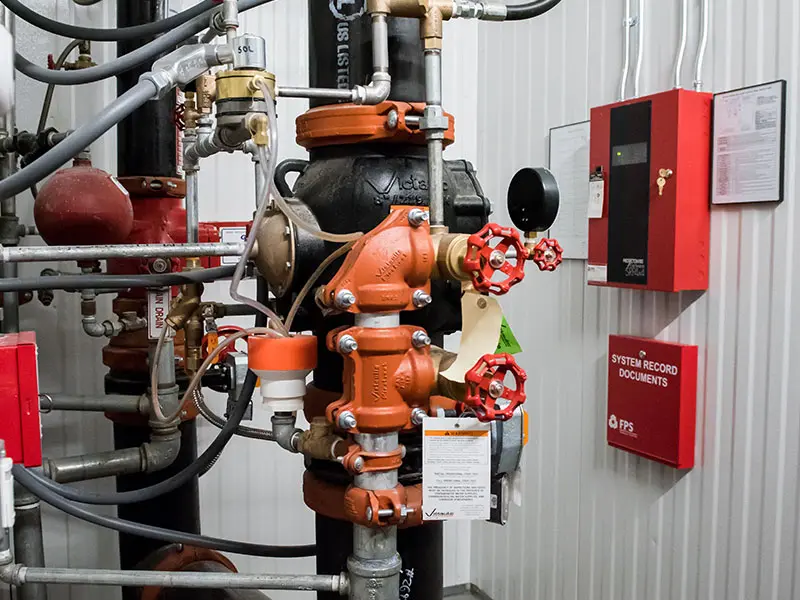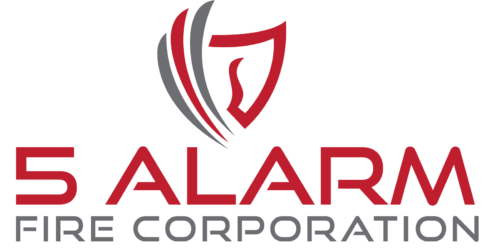
5 Alarm Fire Protection and Sprinkler System Fundamentals
When designing, installing, and servicing a fire protection sprinkler system, one of the primary decisions is selecting the most competent and reliable fire protection contractor. A skilled fire alarm contractor will ensure your building’s fire protection system meets all necessary services and adheres to NFPA and AHJ codes and requirements.
According to NFPA 13, the Standard for the Installation of Sprinkler Systems, there are four main types: wet, dry, preaction, and deluge. Additional extinguishing systems, like clean agent or water mist, fall under different standards. Understanding the distinctions between these systems is crucial to ensure they function effectively in their designated environments. Choosing the wrong type can result in significant costs and inefficiencies.
Wet Pipe Systems
The most common type of sprinkler system is the wet pipe system, where the pipes are constantly filled with water. When a fire heats the air sufficiently, it causes the glass bulb or fusible link in a sprinkler head to break, releasing water immediately from that head. Contrary to Hollywood depictions, not all sprinkler heads activate simultaneously—only those exposed to high enough temperatures will release water. Wet pipe systems are favored for their reliability and cost-effectiveness. However, they are only suitable for spaces that maintain temperatures above 40°F (4°C) to prevent the water from freezing. If this temperature requirement cannot be met, another system type should be considered.
Does your building have an existing fire sprinkler system? If not, General Underground Fire Protection, a subsidiary of 5 Alarm Fire Corporation, specializes in the installation and maintenance of fire sprinkler systems. Our expert team ensures your building is fully protected with the most reliable systems available.
Dry Pipe Systems
Dry pipe systems operate similarly to wet systems, but the pipes are filled with pressurized air or nitrogen instead of water. The water is held back by a dry pipe valve until a sprinkler head activates, releasing the air and allowing water to flow into the pipes and out through the activated sprinkler head. This system is ideal for unconditioned spaces where the temperature could drop below freezing. The main limitation of dry pipe systems is the delay in water delivery due to the time it takes for the water to travel through the pipes.
Preaction Systems
Preaction sprinkler systems are more complex and come in three types: non-interlock, single interlock, and double interlock. These systems require one or more specific events to occur before water is released into the pipes. For example, a non-interlock system fills with water if either the detection system or a sprinkler head activates. A single interlock system requires the detection system to trigger water release, while a double interlock system needs both the detection system and a sprinkler head to activate. Preaction systems are particularly useful in environments where accidental water discharge could cause significant damage, such as museums or data centers. However, the double interlock system’s delayed response time must be carefully considered.
Deluge Systems
Deluge systems use open sprinkler heads and activate water flow simultaneously through all heads when the detection system signals a fire. This system is used in high-hazard areas, such as aircraft hangars, where rapid fire suppression is critical. Deluge systems ensure that water is distributed quickly and broadly to combat fires effectively in environments with high risks.
Choosing the Right Fire Protection System
Selecting the appropriate sprinkler or fire alarm system involves understanding the building and fire protection codes relevant to the specific environment and conditions of the building. The final decision is influenced heavily by the requirements of building codes and the Authority Having Jurisdiction (AHJ) for the building’s location. The selection process isn’t something typically decided by the building owner or property manager. Instead, it falls to architects, fire protection engineers, or fire alarm contractors who design the system and submit it for approval by the AHJ.
Often, a combination of systems may be used to provide comprehensive protection. For instance, in Southern California, buildings might use wet pipe systems in areas with controlled temperatures and dry pipe systems in unconditioned spaces such as parking garages or attics. Each unique environment within the building requires careful consideration to ensure the most appropriate system is applied without sacrificing protection in other areas.
Do you need fire protection certified inspections for your building? At 5 Alarm Fire Corporation, we provide the necessary inspections and alarm monitoring to ensure your building meets all fire safety regulations. Together with General Underground Fire Protection, we maintain all your building’s fire protection requirements seamlessly.
Are you looking for a fire protection company that can provide comprehensive services for both new and existing buildings? 5 Alarm Fire Protection is Located in Orange, CA, we service all Southern California counties, offering top-notch fire protection solutions tailored to your needs.
Enhancing Fire Protection with 5 Alarm Fire Corporation
At 5 Alarm Fire Corporation, we are committed to providing state-of-the-art fire protection services, including the installation and maintenance of advanced sprinkler systems. Our subsidiary, General Underground Fire Protection, specializes in fire sprinkler systems, ensuring your property is safeguarded with the most reliable and effective solutions available. Contact us today to learn more about our comprehensive fire protection services and how we can help you protect your assets and ensure safety.
Bernadette Merrill, Electrical Contractor, Co-Owner of 5 Alarm Fire Protection, Fire Alarm Services Expert, and Content Writer.
